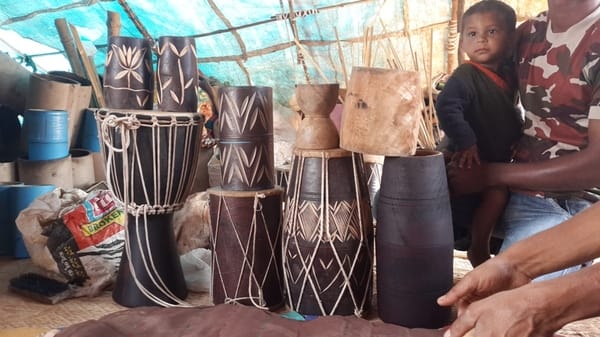
Pic: Huda Jaffer
Drum beats and illuminating LED bulbs powered by the sun… do they have anything in common? Naah, nothing! Ponder over it for a minute.
How are drums made? The typical response would be that the workers gather raw materials, add their labour and voila, the drums are ready.
Here we have workers who actually make drums under light bulbs powered by solar panels. Isn’t that exciting? Eco-friendly drums!
A 500 year old craft
In Thannisandra, a locality of Bengaluru, there is a small community of Mirasis living under the roof of tarpaulin tents. The Mirasis are a nomadic community originally from Uttar Pradesh. They make various types of drums, ranging from small damarus to huge djembes; this has been their craft for the past 500 years. They excel at creating beautiful carvings on delicately crafted percussion instruments. This is now a dying art form, that needs to be preserved.
SELCO Foundation – a sustainable energy NGO, based in Bangalore, looked at this threat to survival, as an opportunity to innovate. The foundation helped create a community-owned business model, called the ‘solar cart’. Under their mentorship, a cart with solar panels on its roof, charges batteries through the panels during the day and illuminate the homes of 30 families at night.
Lighting up their lives
To access the solar power, every family needs to pay Rs 100 a month. This has turned out to be benefecial and cost-effective for the Mirasis. They would earlier spend Rs 15 to 25 a day, to buy kerosene oil, and this worked up to anywhere between Rs 450 to Rs 750 for the month.
Moreover, the light emitted by the kerosene lamps was not bright enough to do minor carvings on the drums. Now, under the glow of solar-powered bulbs, drums are made, family members are fed, children study, and babies too have been delivered (as accessing medical facilities works out rather expensive). In addition, they also charge their cell phones with the additional energy that is stored in the battery.
Since the installation of the solar cart, the Mirasis‘ income has increased by 10 to 20%. With respect to the environmental impact, the carbon emissions saved is equal to that of carbon sequestered by 18 trees every year. And this is precisely why the drums that the Mirasais make are eco-friendly.
A start towards self-sustainability
In order to enhance their livelihood, SELCO Foundation is facilitating projects that can help increase the Mirasis’ access to market linkages. With some support from the foundation’s Urban Community Lab, a stall is being put up at the Sunday Soul Sante on March 9th to sell drums.
The proceeds from the sale of drums at the Sante will be used to initiate a cooperative of drum-makers, to ensure that the intervention becomes self-sustainable.
So here’s calling all music, art and craft lovers to visit their stall – to keep the sound of eco-friendly, hand crafted drum beats and this 500 year old craft, resonating!
Event details
Venue: ITPB Grounds Whitefield, BangaloreDone
Date: Sunday March 9th 2014